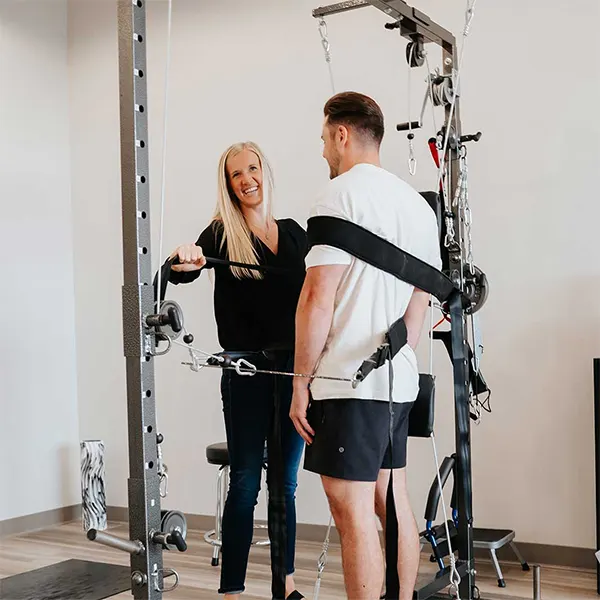Your spine houses your spinal cord, a bundle of nerves that carries messages between the brain and the body. If these nerves are compressed or damaged, it can lead to pain, restricted range of motion, muscle weakness, and dysfunction throughout the body. The discs between each vertebra serve as shock absorbers for the spine, allow for flexibility, and create space for the nerves to exit the spinal cord and service the body. They have a tough, fibrous outer layer surrounding a soft, gel-like center. Due to wear and tear, these discs can start to wear out and even collapse, putting pressure on the adjacent nerves and causing pain, numbness and tingling, muscle weakness, loss of sensation, and other nerve dysfunction.
A bulging disc occurs when the disc’s outer layer weakens or becomes damaged. As a result, the disc protrudes or bulges outward, extending beyond its normal boundaries. The bulge may press against nearby nerves or spinal structures, potentially causing pain and other symptoms. If the outer layer becomes so weak that it tears, the gel-like center can seep out of the disc and apply direct pressure on the nerves. This is a disc herniation.
Treatment for disc injuries, like a disc bulge or herniation, can vary widely. The traditional medical approach to treating disc injuries involves drugs and surgery to remove damaged tissue. The chiropractic approach presents a much sought-after alternative. Chiropractic offers a natural, non-invasive approach to correcting musculoskeletal problems and optimizing the nervous system to function and heal better.
$99 New Patient Special
Includes:
- Consultation
- Thorough Health History
- Chiropractic Exam
- Postural Analysis
- X-rays if indicated
- Report of Findings
How Our Spinal Decompression Plan Works
1. Corrective
This initial stage focuses on addressing specific spinal misalignments and dysfunctions. Through targeted adjustments and specialized techniques, the goal is to restore proper alignment and function to the spine. This phase often involves intensive care to correct existing issues and alleviate pain.
2. Stabilization
The stabilization stage aims to reinforce the changes made. This involves strengthening surrounding muscles, improving posture, and ensuring that the spine maintains its proper alignment over time. Patients typically engage in exercises and receive ongoing adjustments to support long-term stability.
3. Wellness
The final stage emphasizes maintaining optimal spinal health and overall well-being. Wellness care involves regular check-ups and adjustments to prevent future issues and support a healthy lifestyle. This proactive approach helps patients maintain their progress, enhance quality of life, and promote overall health and wellness.
What is Spinal Decompression Therapy?
Spinal decompression therapy reduces spinal pressure by moving the discs back into place and realigning the joints. This can be done through traction, a method that uses stretching and pulling to relieve stress on the spine. A traction table slowly pulls the patient, stretching their spine and relieving pressure on the discs. This can alleviate pain and, more importantly, allow the discs to rehydrate and heal. In the case of a bulging or herniated disc, the soft center, no longer feeling the pressure, can reabsorb into the disc, and the outer layer has the chance to heal.
A decompression session can take 10-15 minutes and is pain-free. Many patients report that decompression feels good, as it relieves stress on the spine that is causing pain and other symptoms.
Common conditions and symptoms that are effectively treated by spinal decompression include:
Who Can Benefit From Spinal Decompression in Fargo, ND?
Athletes, office workers, seniors, people injured at work, auto accident injury victims, and anyone suffering from back pain may benefit from this form of therapy.
Spinal decompression therapy may help athletes’ performance, flexibility, pain relief and recovery, and muscle soreness.
Office workers, or anyone sitting for long periods, may be in danger of developing spinal compression through the pressure from prolonged sitting and bad posture.
Seniors typically deal with spinal issues as their bodies age, and their discs deteriorate. The therapy can help slow down this process and strengthen muscles and tendons, resulting in better flexibility and range of motion.
Accident victims can also benefit from spinal decompression therapy if they have some spine-related trauma.
Benefits of Spinal Decompression and Chiropractic Care in Fargo, ND
You can reduce back pain by decompressing pressure on nerves, muscles, and discs in your spine through spinal decompression therapy. It is easier to treat problems through this type of therapy as fewer risks are involved. There is no need to take time off of work to recover. In just 10-15 minutes, decompression can reduce muscle spasms and improve muscle strength and flexibility.
Spinal Decompression Therapy helps to improve your circulation by increasing blood flow to the area and allowing your heart to pump more efficiently. You will feel less tired after treatment as a result. You can move more freely and possibly even notice a change in your posture if you have upper back, neck, and shoulder issues.
Spinal decompression therapy is combined with chiropractic care to help patients improve their flexibility, range of motion, and overall health. You can see improvements after only a few treatment sessions, empowering you to return to your daily activities more efficiently.
Check Out Our Location Near You
3260 Veterans Blvd Suite 105, Fargo, ND 58104
Frequently Asked Questions About Spinal Decompression Therapy
What is spinal decompression therapy?
This particular type of therapy is non-invasive and aims at reducing back or neck pain by gradually stretching the spine to reduce pressure on nerves by alleviating tension on spinal discs.
How does spinal decompression work?
Spinal decompression uses a mechanical device in providing traction to the spinal discs in order to encourage the intake of oxygen, water, and nutrients by the discs.
What conditions can be treated with spinal decompression?
Individuals suffering from herniated discs, bulging discs, degenerative disc disease, sciatica, facet syndrome, back pain, neck pain and spinal stenosis can benefit from decompression therapy.
Does spinal decompression therapy hurt?
Spinal decompression therapy is generally not painful, is mostly comfortable and, in most cases, painless. The patient might, however, feel some gentle stretching pressure during the procedure.
How many decompression sessions are needed and what is the outcome?
Usually, it is recommended to go through a course of 20 – 25 decompression sessions. The outcome varies from patient to patient but most patients report that they feel significant reduction in pain and an improvement in overall mobility.
Start Your Health Journey



